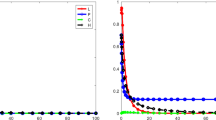Abstract
Being sessile organism, plants have to deal with environmental stresses like herbivore attack, competition with neighboring plants in different ways. Plant produced volatile plays a major role in plant defense. After herbivore attack, plant induced volatile attracts the natural enemies of herbivore. So, natural enemies enter the plant herbivore system. There are lots of works on growth and defense for individual plants whereas it is essential to analysis the trade-off between growth and defense in context of plant as a member of plant community. In this paper we address the effect of plant–plant competition and herbivore induced volatile in four species plant–herbivore–carnivore system. We outline the various role of volatile in plant competition and defense. Besides local stability, we also study the global behavior at the densities of all population at equilibrium point. We discuss the conditions for long term survival of all population. We analyze different types of bifurcations at the various steady states. Finally, numerical simulations are carried out to illustrate our obtained results.








Similar content being viewed by others
References
Agrawal AA (2000) Mechanisms, ecological consequences and agricultural implications of tri-trophic interactions. Plant Biol 3:329–335
Ballar CL, Mazza CA, Austin AT, Pierik R (2012) Canopy light andplant health. Plant Physiol 160:145–155
Bi HH, Zeng RS, Su LM, An M, Luo SM (2007) Rice allelopathy induced by methyl jasmonate and methyl salicylate. J Chem Ecol 33:1089–1103
Birkhoff G, Rota GC (1982) Ordinary differential equation. Ginn and Co., Boston
Blower SM, Dowlatabadi H (1994) Sensitivity and uncertainty analysis of complex models of disease transmission: an HIV model, as an example. Int Stat Rev 62:229–249
Cipollini D (2004) Stretching the limits of plasticity: can a plant defend against both competitors and herbivores? Ecology 8:2837
Cook SM, Khan ZR, Piekett JA (2007) The use of push-pull strategies in integrated pest management. Ann Rev Entomol 52:375–400
Copolovici L, Niinemets Ü (2016) Environmental impacts on plant volatile emission. In: Blande JD, Glinwood R (eds) Deciphering chemical language of plant communication. Springer, Cham, pp 35–60
Dicke M (1994) Local and systemic production of volatile herbivore-induced terpenoids: their role in plant–carnivore mutualism. J Plant Physiol 143:465–472
Dicke M (1999) Evolution of induced indirect defense of plants. In: Tollrian R, Harvell CD (eds) The ecology and evolution of inducible defenses. Princeton University Press, Princeton, pp 62–88
Dicke M, Baldwin IT (2010) The evolutionary context for herbivore-induced plant volatiles: beyond the “cry for help”. Trends Plant Sci 15:167–175
Dicke M, Sabelis MW (1988) How plants obtain predatory mites as bodygurds. Neth J Zool 38:148–165
Fang CX (2009) Analysis of gene expressions associated with increased allelopathy in rice (Oryza sativa L.) induced by exogenous salicylic acid. Plant Growth Regul 57:163172
Fergola P, Wang W (2011) On the influences of defensive volatiles of the plants in tritrophic interactions. J Biol Syst 19:345–363
Freedman HI, Waltman P (1984) Persistence in models of three interacting predator-prey populations. Math Biosci 68:213–231
Guerrieri E (2016) Who’s listening to talking plants? In: Blande JD, Glinwood R (eds) Deciphering chemical language of plant communication. Springer, Cham, pp 117–130
Heil M (2008) Indirect defence via tritrophic interactions. Tansley Rev 178:41–41
Herms DA, Mattson WJ (1992) The dilemma of plants: to grow or todefend. Q Rev Biol 67:283–335
Hilker M, Meiners T (2011) Plants and insect eggs: how do they affect eachother? Phytochemistry 72:1612–1623
Hummel GM (2009) Herbivore-induced jasmonic acid bursts in leaves of Nicotiana attenuata mediate short-term reductions in root growth. Plant Cell Environ 32:134–143
Karban R (2001) Communication between sagebrush and wild tobacco in the field. Biochem Syst Ecol 29:995–1005
Karban R et al (2004) The specificity of eavesdropping on sagebrush by other plants. Ecology 85:1846–1852
Karban R (2004) The specificity of eavesdropping on sagebrush by other plants. Ecology 85:1846–1852
Kegge W, Peirik R (2010) Biogenic volatile organic compounds and plant competition. Trends Plant Sci 15:126–132
Kigathi RN, Weisser WW, Veit D, Gershenzon J, Unsicker SB (2013) Plants suppress their emission of volatiles when growing with conspecifics. J Chem Ecol 39:537–545
Li MY, Muldowney J (1993) On Bendixon’s criterion. J Differ Equ 106:27–39
Liu YH, Zeng RS, Liu DL, Luo SM, Wu HW, An M (2006) Modelling dynamics of plant defence volatiles using the An–Liu–Johnson–Lovett model. Allelopath J 18:215–224
Liu YH, Liu DL, An M, Fu YL, Zeng RS, Luo SM, Wu H, Pratley J (2009) Modelling tritrophic interactions mediated by induced defence volatiles. Ecol Model 220:3241–3247
Marder M (2013) Plant intelligence and attention. Plant Signal Behav 8:e23902
Mithöfer A, Boland W (2012) Plant defense against herbivores: chemical aspects. Plant Biol 63:431–50
Mukherjee D (2018) Dynamics of defensive volatile of plant modeling tritrophic interactions. Int J Nonlinear Sci 25:76–86
Perko L (2000) Differential equations and dynamical systems, 3rd edn. Springer, Berlin
Pierik R, Visser EJH, de Kroon H, Voesenek L (2003) Ethylene is required in tobacco to successfully compete with proximate neighbours. Plant Cell Environ 26:1229–1234
Sobhy IS, Erb M, Lou Y, Turlings TCJ (2014) The prospect of applying chemical elicitors and plant strengtheners to enhance the biological control of crop pests. Philos Trans R Soc B 369:20120283
Staswick PE (1992) Methyl jasmonate inhibition of root-growth and induction of a leaf protein are decreased in an Arabidopsis thaliana mutant. Proc Natl Acad Sci USA 89:6837–6840
Sun C, Loreau M (2009) Dynamics of a three-species food chain model with adaptive traits. Chaos Solitons Fractals 41:2812–2819
Takabayashi J, Dicke M (1996) Plant–carnivore mutualism through herbivore-induced carnivore attractants. Trends Plant Science 1:109–113
Acknowledgements
This research of Ritwika Mondal was supported by DST/INSPIRE Fellowship/2015/IF 150747. The authors are grateful to the anonymous reviewers for their helpful comments and suggestions for improving the paper.
Author information
Authors and Affiliations
Corresponding author
Rights and permissions
About this article
Cite this article
Mondal, R., Kesh, D. & Mukherjee, D. Influence of competition in modelling dynamics of plant defense with induced volatile. Model. Earth Syst. Environ. 4, 1197–1211 (2018). https://doi.org/10.1007/s40808-018-0481-6
Received:
Accepted:
Published:
Issue Date:
DOI: https://doi.org/10.1007/s40808-018-0481-6




